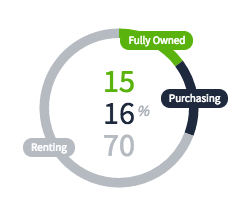Watch Out For This Simple Stat
 One way to differentiate between a sophisticated investor and a property speculator is to observe how much pre-purchase homework they complete. A sophisticated investor seeks to manage their risk by asking questions, gathering evidence and completing further research. A speculator purchases on gut feel and hopes everything works out okay.
One way to differentiate between a sophisticated investor and a property speculator is to observe how much pre-purchase homework they complete. A sophisticated investor seeks to manage their risk by asking questions, gathering evidence and completing further research. A speculator purchases on gut feel and hopes everything works out okay.
You may not know it, but for the past 18 months I’ve been working on a brand new product – Buyer Beware – that is surely the most comprehensive resource ever written on the topic of due diligence as it relates to real estate.
Included in it is my step-by-step methodology for completing due diligence, forged on the back of completing hundreds of property transactions over 15 years, that will help you to comprehensively analyse your next property purchase like a pro.
It won’t be ready for public release for a little while yet, but I wanted to share one useful tip that’s mentioned in it.
Area Analysis
 As you’d expect, what you buy (i.e. the “bricks and sticks” – aka the dwelling) is very important. So too is where you buy (i.e. the suburb or location).
As you’d expect, what you buy (i.e. the “bricks and sticks” – aka the dwelling) is very important. So too is where you buy (i.e. the suburb or location).
Perhaps the best and most succinct piece of real estate advice I can give about selecting an area is: buy the best house you can afford, in the best area you can afford. If you have to sacrifice one or the other, sacrifice the quality of the house rather than the area.
In Buyer Beware I explain fifteen critically important factors to consider when assessing an area. One of those is ‘Social Demographics’, and one of the key statistics to examine under this heading is the percentage of people who own in an area versus those who rent.
A suburb where more people rent indicates a higher percentage of housing owned by investors. In the event of a sudden downturn, these areas will be harder hit than those where home-ownership is higher – for at least two reasons:
- On the supply side, investors will undercut each other in the rush to exit while they can, before their equity evaporates.
- On the demand side, without many homeowners to mop up the extra stock, the only buyers for those on sale would be other investors who will likely be reticent to buy given the freefalling of prices in the area.
Conversely, a suburb with a higher percentage of homeowners than renters provides a cushion against sudden price shocks, given that homeowners are more emotionally attached to their homes. Also, in all likelihood, they will probably be carrying less debt and can afford to “hold on” right through to recovery in the future. So long as they keep their income, there is little need to sell – instead, they “batten down the hatches” and wait it out. Thus values won’t be as likely to plunge in their area.
When you drill down further by splitting between homeowners who have a mortgage and those that own their homes outright, the results can be very interesting.
 Take Moranbah in Queensland for example. Prices exploded there during the mining boom, before spectacularly collapsing. One thought may be whether or not now, with commodity prices on the rise, Moranbah might be a good suburb to target.
Take Moranbah in Queensland for example. Prices exploded there during the mining boom, before spectacularly collapsing. One thought may be whether or not now, with commodity prices on the rise, Moranbah might be a good suburb to target.
Let’s see what the home ownership metric has to say about it. Rounded up, the stats look like this – 15% are fully owned, 16% are purchasing, and a whopping 70% are renting. In other words, 7 out of every 10 homes in Moranbah are rented.
Compare that with Canterbury in Victoria where 46% are fully owned, 30% are purchasing and 24% renting. With such a high percentage owning, Canterbury would be expected to have much less inherent risk of a price decline because of a sudden downside shock to demand or supply.
When an area has more than 50% of houses that are rented rather than owned, then it should not necessarily be avoided completely, but it is a red flag that is seen by wise investors as a reason to be cautious.
Applying this theory to Moranbah, even though prices are low, considerable risk remains given the high percentage of renters. Personally, if I wanted to target a mining town, I’d look for another location that had a higher percentage of homeowners.
If you’ve enjoyed this discussion you can watch the following short training video where I show you how to access the statistics:
Conclusion
As you’ll discover, if you invest in acquiring and using Buyer Beware, there is much you can do to protect yourself from buying a lemon. As far as today’s lesson is concerned though, remember this rhyme:
Beware a sudden price descent
In areas where more people rent
Do you have a favourite saying or investing tip? Please share it with the world by posting a comment below.
Stay happy and remember that success comes from doing things differently.
– Steve McKnight
P.S. If you want to pre-register your interest (no-obligation) in accessing the full power of my comprehensive due diligence system, and at the same time qualify for a special one-time discount, then click here to be added to a special Buyer Beware database. You’ll receive more information by email once it is available.
Comments
Got something to say? Post a comment...
You must be logged in to post a comment.





Hi Steve,
Are those statistics built off the ABS?
And therefore several years behind?
Just thinking of how recent the data is.
Thanks
BS
Hi Ben,
My understanding is that the stats are based on census information, so it is updated every 4 years. I am not sure of other data sources that might be more current in the meantime.
Regards,
– Steve
Steve, your information is always so helpful. Thank you
You’re welcome Yuna.
Hi Steve
Love your work. Am just starting out I have two properties and am devouring your books. Where and how do I access the information on towns and areas? How do I find out what are bad and good areas of towns. Sometimes I won’t be able to go to the town I purchase in. So how do I get this information more easily. Any tips will be appreciated Cheers
Thanks Laura. The resource that I am writing called Buyer Beware will help. It is still a few months away from being completed though. Be sure to register your interest at the link at the bottom of the articl.
Cheers,
– Steve
Thanks Steve.
There are a number of examples available like Port/South Hedland, Newman etc. they all are falling in “renting” category by more than 70% and had seen similar outcomes which were known to everyone.
Also, you might add one more aspect in the above, higher family income in these suburbs could not stop bad impacts of more rental VS less owned houses scenario, meaning, even with higher family incomes properties in these suburbs could not survive.
Thanks.
regards
Bhavesh
Yes. Excellent point Bhavesh.
– Steve
Steve,
Some historical perspective would be useful on this stat, increasing home ownership may indicate changes to the demographic profile, is this sort of information readily available?
Interesting analysis on demographics Steve.
It makes sense.
Thanks
Hi Steve,
What are your thoughts on suburbs like Carlton, VIC with high demand for student rentals? Wouldn’t the constant demand for this type of property stabilize the possibility of a decline in price and yield as apposed to a suburb that’s demand is reliant on a resource such as Newman, WA?
Hi Mack85n,
Yes, with Melbourne and RMIT universities close, this is a popular location for students. But remember that students usually look for affordable, and so that puts a glass ceiling on rent escalation, and will have the effect of restricting yields and values.
Sincerely,
– Steve
thanks for the insight Steve AWESOME!!!!
Would have like you to do some on the major cities.
Acknowledgement for your Wisdom and knowledge